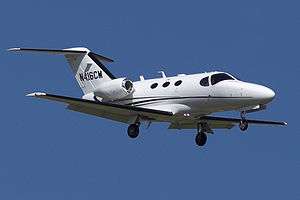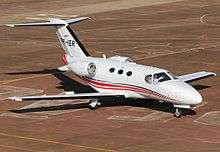Cessna Citation Mustang
The Cessna Citation Mustang (Model 510) is a very light jet that was built by Cessna. Launched at the 2002 NBAA convention, it first flew on 23 April 2005. It received its FAA type certification September 8, 2006, was first delivered on November 22. Production ended in 2017 after 479 aircraft were built. The 8,645 lb (3,921 kg) MTOW jet is powered by two 1,460 lbf (6.5 kN) P&WC PW615F turbofans, can reach 340 kn (630 km/h) and has a range of 1,167 nmi (2,161 km).
| Citation Mustang | |
|---|---|
 | |
| Citation Mustang | |
| Role | Business jet |
| National origin | United States |
| Manufacturer | Cessna |
| First flight | 23 April 2005[1] |
| Introduction | 2006 |
| Status | Production completed |
| Primary users | GlobeAir AG, Hoersching, Austria (16)[2] WiJet, Paris (6) + Blink Ltd, London (9), Aeropartner A.S., Prague (4), Oyonnair SARL, Lyon, France (3)[2] |
| Produced | 2006–2017 |
| Number built | 479[3] |
| Unit cost |
$3.35 million USD (2015)[4] |
Development
Launched at the 2002 NBAA convention, the $2.4 million Mustang first flew on 23 April 2005.[1] The airplane received full type certification from the Federal Aviation Administration on September 8, 2006. Cessna received FAA certification to fly into "known icing conditions" on November 9, 2006.[5] Cessna delivered the first production LJ on November 22, 2006, the same day the FAA awarded Cessna with the necessary certification.[6] Dave and Dawn Goode of GOODE Ski Technologies received the first retail delivered Cessna Mustang on April 23, 2007.[7]
In 2010, Cessna launched an enhanced edition of the aircraft called the High Sierra, which features higher quality cabin furnishings and enhanced avionics, including synthetic vision.[8]
Cessna ended production of the design in May 2017. Production ended due to lack of customer demand for the aircraft, as a result of competition from the company's own Cessna Citation M2. The company had been selling an average of 40 Mustangs per year until the M2 was introduced in 2013 and then Mustang sales dropped to just 24 aircraft over the next three years. The M2 is a faster and larger aircraft, but can operate from similar length runways and requires the more common C/E-525 type rating, which potentially reduces training and crewing costs over the Mustang.[9][10] A total of 479 examples of the Citation Mustang were produced.[3]
In 2018, used 2009-2016 Mustangs were priced at $1.85-2.5 million.[11]
Design


The Mustang is a low-wing cantilever monoplane with a swept wing, T-tail and retractable tricycle gear. One main door is located in the forward left section of the aircraft, with an additional emergency exit on the center right section of the fuselage. The Mustang, in standard configuration, has four passenger seats in the aft cabin, a toilet, and seating for two in the cockpit. The airframe is primarily of aluminum alloy construction, with a three spar wing. Power is provided by two Pratt & Whitney Canada PW615F turbofans, mounted in pods on the aft fuselage. It was built at the Cessna production facility in Independence, Kansas.
Like many other light jets, the Mustang is approved for single-pilot operation.[12]
Specifications

Data from Cessna Aircraft Company[13]
General characteristics
- Crew: one or two pilots
- Capacity: 4 to 5 passengers and 3130 lb (1420 kg) useful load
- Length: 40 ft 7 in (12.37 m)
- Wingspan: 43 ft 2 in (13.16 m)
- Height: 13 ft 5 in (4.09 m)
- Empty weight: 5,600 lb (2,540 kg)
- Max takeoff weight: 8,645 lb (3,930 kg)
- Powerplant: 2 × Pratt & Whitney Canada PW615F turbofans, 1,460 lbf (6.5 kN) thrust each
Performance
- Maximum speed: 483 mph (777 km/h, 420 kn)
- Cruise speed: 390 mph (630 km/h, 340 kn)
- Range: 1,343 mi (2,161 km, 1,167 nmi) (at max. takeoff weight)
- Service ceiling: 41,000 ft (12,500 m)
- Rate of climb: 3,010 ft/min (15.3 m/s)
- Thrust/weight: 0.337 (at max. takeoff weight)
- Takeoff distance: 3,110 ft (948 m)
- Landing distance: 2,380 ft (729 m)
Avionics
Operators
Half of the fleet is in the U.S. and Canada, mostly operated by firms or individuals owning a single aircraft and typically flown by their owners, with some owners defraying a portion of the fixed operating costs by sharing use with air charters. Outside of North America, most are exclusively flown by third-party crews. Most of the other half of the fleet is based in Europe: 23 aircraft in the British Isles, 20 aircraft in Austria, 20 in France, 11 in Germany, six in the Czech Republic, five in Switzerland and four in Italy. In Latin America, Brazil has 31 aircraft, there are 10 in Mexico, three in Argentina, two in Venezuela and one each in Chile, Guatemala, Panama and Paraguay. In the Middle East four are in Turkey, as in Egypt and two are in Israel. Six are in Africa, nine in Australia and five in New Zealand.[2]
| year | 2006 | 2007 | 2008 | 2009 | 2010 | 2011 | 2012 | 2013 | 2014 | 2015 | 2016 | 2017 | total |
|---|---|---|---|---|---|---|---|---|---|---|---|---|---|
| deliveries[3] | 1 | 45 | 101 | 125 | 73 | 43 | 38 | 20 | 8 | 8 | 10 | 7 | 479 |
Accidents
- On Thursday 14 December 2017, OE-FWD operated by Skytaxi Luftfahrt from Egelsbach Airport crashed approaching to Friedrichshafen Airport, Germany, 15 km from the runway, killing the lone passenger and the two crewmembers including its captain, company CEO and chief pilot Adi Anderst. This was the type's first fatal accident and its first major accident in a decade.[14]
See also
Aircraft of comparable role, configuration and era
- Eclipse 500 / 550
- Embraer Phenom 100
- Cessna Citation M2
- HondaJet
- Cirrus Vision SF50
Related lists
References
- "Cessna's Citation Mustang Takes to the Sky" (Press release). Wichita, KS: Textron. 26 April 2005. Retrieved 29 June 2016.
- Fred George (Dec 21, 2016). "Operators Survey: Cessna Citation Mustang". Business & Commercial Aviation. Aviation Week.
- "2017 Annual Report" (PDF). General Aviation Manufacturers Association. 2018. Archived from the original (PDF) on 2018-04-10. Retrieved 2018-08-08.
- "Business Jets Specification and Performance Data" (PDF). Business & Commercial Aviation. Aviation Week. May 2015.
- "Cessna Citation Mustang Cleared for Flight Into Known Icing Conditions" (Press release). Wichita, KS: Textron. 9 November 2006. Retrieved 2 June 2009.
- Trautvetter, Chad (22 November 2006). "Cessna Beats Out Eclipse In First VLJ Delivery". AVweb. Retrieved 29 November 2006.
- "Cessna Delivers First Retail Citation Mustang" (Press release). Independence, KS: Textron. 24 April 2007. Retrieved 18 July 2007.
- Aero-News Network (3 January 2011). "Aero-TV: Cessna's 'High Sierra' Mustang - Cost Effective Luxury at FL410". Retrieved 15 November 2016 – via YouTube.
- Rapoport, Geoff (11 May 2017). "Cessna Ends Mustang Production". AVweb. Retrieved 12 May 2017.
- Chad Trautvetter (May 11, 2017). "Textron Ceases Production of Cessna Citation Mustang". Aviation International News.
- Mark Huber (December 2018). "For many models, market hitting the apex" (PDF). Aviation International News. pp. 20–21, 24.
- McClellan, J. Mac (February 2008). "Learning to Fly the Mustang". Pilot Reports. Flying. Vol. 135 no. 2. Hachette Filipacchi Media U.S. p. 53. ISSN 0015-4806. Retrieved 27 June 2016 – via Google Books.
- "Citation Mustang Specifications". Cessna Aircraft Company. Archived from the original on 27 May 2016. Retrieved 14 June 2016.
- Curt Epstein (December 15, 2017). "European Mustang Crash Claims Three". AIN.
External links
| Wikimedia Commons has media related to: |